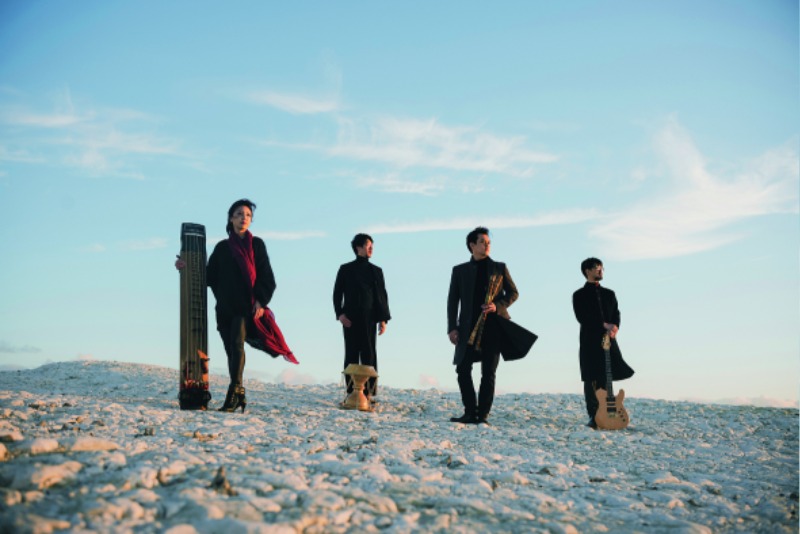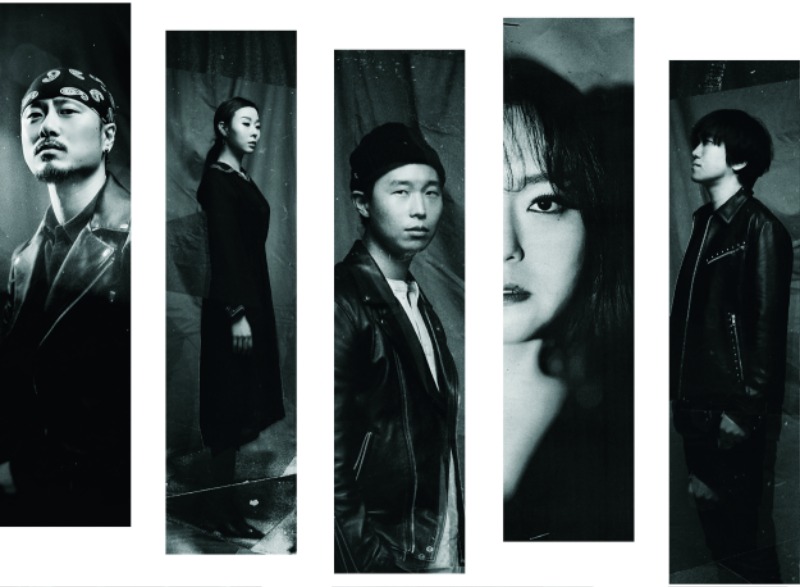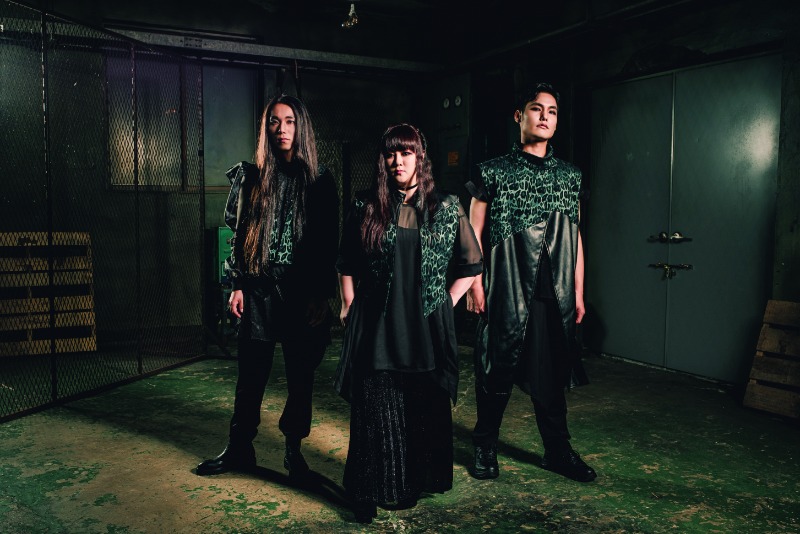Breathing new life into music from hundreds of years ago, pioneers of contemporary gugak (traditional Korean music) spearhead crossovers resonant with energy and inspiration. Here are three notable groups at the vanguard of innovation, each carving a singular path and enticing audiences at home and abroad.
Black
“Though you may devote your life to it, achieving the authentic sound of the geomungo is an elusive goal. In a broad sense, this is not much different from what Blackaspires to.”

Black , formed in 2011, s experimental sounds based on improvisational fusion of traditional Korean music and jazz. Its four members are, from left: Yoon Jeong Heo on geomungo, Min Wang Hwang on ajaeng and janggu, Aram Lee on daegeum and yanggeum, and Jean Oh on guitar.
© Nah Seung-yull
Blackhas been gaining recognition at local and global festivals of world music and jazz over the years. As their name proclaims, the four-member group plays music deeply rooted in the geomungo, a six-ed zither, whose Sino-Korean name literally means “black .” This native Korean instrument, dating back 1,500 years, s a modest, solemn tone epitomizing the dignity of traditional Korean music.
The group, formed in 2011, consists of Yoon Jeong Heo on geomungo, Jean Oh on guitar, Aram Lee on daegeum (large transverse bamboo flute) and yanggeum (hammered dulcimer), and Min Wang Hwang on ajaeng (seven-ed bowed zither) and janggu (double-headed drum). Their career took off in 2016 when they signed with the world-renowned German record label ACT, a first for a Korean ensemble. Under their contract, they will release five full-length albums with the company. Together with ECM, ACT is known for its experimental contemporary music with a focus on jazz.
Black ’s first album, “Mask Dance,” released that same year, earned them an award in the Asian and Pacific category at the 2018 Songlines Music Awards held in Britain, also a first for a Korean act.
Their music may actually seem a better match with the style of ECM, which cultivates a blend of European folk music and meditative jazz. The philosophical reinterpretation of ambient music in the title track of their second album, “Karma” (2019), and the fusion jazz approach explored in “Exhale-Puri” or “Song of the Sea” are close to a Korean-style ECM.
Behind the group’s innovative endeavors is leader Yoon Jeong Heo, a prominent geomungo p and professor of traditional Korean music at Seoul National University. She is the daughter of Heo Gyu (1934-2000), a pioneer in madanggeuk (traditional outdoor theater) who significantly broadened the horizons of Korean theater in the 20th century. “Through my father, I got to know masters of traditional improvisational music,” she recalls. “I was greatly inspired by haegeum [two-ed fiddle] p Kang Eun-il. His performances broke free from the conventional boundaries of our traditional music.”
Along with Kang, Yoon Jeong Heo is now at the forefront of free experimentation in traditional Korean music. They formed SangSang Trio with Yu Kyung-hwa, a p of the cheol-hyeongeum (steel-ed zither), creating music that merges traditional flourishes and rhythms with free jazz or modern music methodology. Yu and Won Il, the composer who collaborated with them, were Heo’s classmates at Gugak National High School.
The other three members of Blackare prominent young musicians in the fields of traditional Korean music and jazz, who work on both solo and group projects. They are audacious in their choices, mixing elements from a diverse repertoire spanning traditional folk, shamanic and Buddhist music, and English rock band Radiohead’s “Exit Music – For a Film,” and offering up a dreamy musical concoction. Aram Lee delivers an original, virtuoso performance on the daegeum; Min Wang Hwang has played with Lee on other projects; and Jean Oh is known for his minimalistic yet profound guitar play. Their music demonstrates that they are not mere accompaniments to the geomungo. Those just initiated into the world of traditional Korean music would do well to remember the names of these musicians.
“I love to improvise, but our team’s identity isn’t based on improvisation alone. The clear concept and character of a piece are the basic framework and improvisation is the impetus for our performance,” says Heo. In that sense, sanjo, the traditional free-style solo instrumental, is the root and heart of Black ’s music.
Jambinai
“How shocked you’d feel to see before your eyes an animal thought to be extinct or not of this world, or to catch a deep-sea creature like the coelacanth alive. That’s the kind of thing we’re seeking.”

Post-rock band Jambinai is recognized for its blend of rock and heavy metal on traditional Korean instruments. From left: Jaehyuk Choi on drums; Eun Yong Sim on geomungo; Ilwoo Lee on guitar, piri and taepyeongso; Bomi Kim on haegeum; and B.K. Yu on bass guitar.
© Kang Sang-woo
Hellfest, a global metal music festival with a rather scary name, brings tens of thousands of hot-blooded youths to a small town in France ever y June. The main acts are hard rock and heavy metal bands, such as Iron Maiden and Cannibal Corpse. So in 2016, the audience was puzzled at an array of Asian instruments brought on stage. They were for a performance by Jambinai, a five-member post-rock band from Korea.
Jambinai, formed in 2009, consists of Ilwoo Lee, a versatile p of the guitar, piri (double-reed oboe) and taepyeongso (conical oboe); Bomi Kim on haegeum; Eun Yong Sim on geomungo; Jaehyuk Choi on drums; and B.K. Yu on bass guitar. Their music evokes a bizarre bedlam of Korean goblins and ghosts. When the jagged sounds of the geomungo’s loop, d by striking the body and s with the plectrum in one stroke, meet the ghostly screech of the haegeum and roar of the electric guitar, the audience is hit by a feeling of horror and suspense that is unlike anything in heavy metal. The frictional and affricate sounds produced by the haegeum and geomungo are unfamiliar yet electrifying. The aesthetics of postrock, shoegazing, metal and traditional Korean music clash in unpredictable proportions.
The group’s key members – Ilwoo Lee, Bomi Kim and Eun Yong Sim – chose to pursue traditional music at a young age. They were classmates at the Korea National University of Arts’ School of Traditional Korean Arts. But Jambinai was born from Lee’s defiance of Korea’s musical tradition. He began playing the piri in seventh grade and took up electric guitar in ninth grade. While studying traditional Korean music at school, he watched Metallica performances at home, dreaming of becoming a rocker one day. Prior to Jambinai, he played in the screamo band 49 Morphines.
“They say that traditional Korean instruments can’t blend with band music, and that traditional Korean music is boring and only belongs in places like hanok homes. I wanted to break such prejudices,” Lee says. “To do that, I had to come up with a powerful sound. I got an idea from ‘Roots,’ an album by Sepultura, a band that melds traditional Brazilian music with metal. Other influences were the industrial rock sound collage in ‘The Downward Spiral,’ an album by Nine Inch Nails, and the post-rock genre where diverse instruments, from violin and cello to bagpipes, mesh smoothly with the rock sound.”
In 2014, Jambinai was invited to the SXSW Music Festival in Austin, Texas, United States. The group had an audience of two people to start with, but in some 30 minutes were playing to a full house. For me, seeing this in person was among my most intense concert experiences. In 2015, the band signed with British record label Bella Union, and the following year, globally released their second album, “A Hermitage,” to rave reviews. Their dramatic sound, which starts off like a candle flame then grows into a wildfire, encompasses a wide spectrum – from the fierce (“Time of Extinction” from their debut album “Differance,” “Wardrobe” off their second album “A Hermitage” and “Event Horizon” from their third album “ONDA”) to the meditative (“Connection,” the last track on their first album).
Before COVID-19, Jambinai had more than 50 overseas performances each year. They mesmerized audiences at international music festivals, including WOMAD UK, EXIT in Serbia and Roskilde in Denmark. They gave a spectacular performance at the closing ceremony of the 2018 Winter Olympics in Pyeongchang.
Dongyang Gozupa
“I believe that our shortcomings are what spur us to be more creative. Although it’s just us three, we want to be a team that fills the space completely with our music alone.”

Dongyang Gozupa, formed in 2018, is known for its wild and jarring style, as suggested by its name which literally means “high frequency from the East.” From left: Jang Do Hyuk on percussion, Yun Eun Hwa on yanggeum and Ham Min Whi on bass guitar.
© Kim Shin-joong
When it comes to being unconventional, the trio Dongyang Gozupa doesn’t fall behind the previous two groups. For starters, the band’s eccentric name says a lot: it literally translates as “high frequency from the East.” Jang Do Hyuk, the percussionist, explains he conceived the name from the signboard of a neighborhood electronics repair shop. He thought it suited the band’s wild and jarring musical style.
The group debuted in 2018 with the release of an EP titled “Gap.” Dominating first impressions of their music is the sound of the yanggeum played by Yun Eun Hwa, which pounds down like a squall. Her performance visually overpowers the downpicking guitar pelting down like a rainstorm, as seen in Metallica’s “Master of Puppets.” Ham Min Whi’s deep bass guitar and the swift interplay of Jang Do Hyuk’s percussion complete their sound, dashing forward at breakneck speed. The clear timbre of the yanggeum bounces around like raindrops falling in a tropical rainforest. This hammered dulcimer is the band’s centerpiece. It is made with metal s, whereas the geomungo in Blackand Jambinai has silk s. Yun produces metallic sounds on the instrument that are suggestive of heavy metal.
The yanggeum originated in Persia. Over time, it was adapted and modified in diverse ways, and was given names like zither, dulcimer and cimbalom. It was introduced to Korea by way of China and was dubbed yanggeum, which means “ instrument from the West.” Along with the saenghwang (freereed mouth organ with 17 bamboo pipes), it is one of the few traditional instruments that can play the scales and harmony used in Western music.
Yun, who heads the Korean chapter of the Cimbalom World Association, had her instrument custom made. “The traditional yanggeum is smaller and produces only a narrow range of notes, which makes it unsuitable for playing diverse genres,” she explains. “My yanggeum has a much wider range, covering four and a half octaves, and is capable of producing the chromatic scale like Western musical instruments. So it can play just about any genre of music. I added a pickup that amplifies the sound, as well as effects pedals to expand the expressive range.”
Yun began studying music at the age of four in China, where she learned to play the North Korean yanggeum, and majored in percussion at college in Korea. Her idiosyncratic style was honed through years of practice and study, assimilating the merits of percussion andinstruments of the East and West, and of North and South Korea.
Jang Do Hyuk, meanwhile, is a unique percussionist. He doesn’t play a foot-operated kick bass drum; instead of playing with both hands and feet, he has d a signature style using hands alone to express the entire spectrum of percussion sounds, from low to high pitch. A former member of Danpyunsun and the Sailors, a band that combines rock and Eastern influences, Jang says, “Limitations are what allow me tomy own distinctive sound. I love the challenge.”
Ham Min Whi’s bass guitar flows smoothly from weighty to agile movements, reminiscent of the American nu metal band Korn or the punk rock band Red Hot Chili Peppers.
In 2021, Yun Eun Hwa received the Soorim New Wave Award given by the Soorim Cultural Foundation. This prestigious award is presented each year to just one young traditional musician or team specializing in experimental styles. Other recipients include Kwon Song Hee, vocalist of the alternative pop band LEENALCHI, and Ak Dan Gwang Chil (ADG7), a folk-pop group that puts a modern spin on shamanic ritual music from Hwanghae Province, located in present-day North Korea.
Dongyang Gozupa was the first Asian band to be invited to the global music festival WOMEX for two consecutive years, in 2020 and 2021.